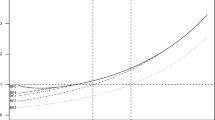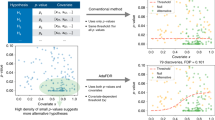Abstract
The validation of the results obtained by hypothesis testing is of special interest in applications that deal with high-dimensional sets of variables. The use of equivocated statistical methods may result in poor control of false positives. On the other hand, overconservative methods may prevent relevant findings. In this paper we define dependence aliasing as the spurious dependence relationship among variables that appears when the number of samples is lesser than the number of variables of a study. We present a novel method for estimating the adjusted p-values in applications that require multiple hypothesis testing. The method increases the statistical power of the results by exploring the dependence among the variables, while controlling false positives in strong sense. The method is compared to other relevant adjustment models such as the false discovery rate method and resampling. We illustrate the effectiveness of the method in medical imaging studies involving progressively larger sets of variables. The results show that the proposed method is able to compute adjusted p-values that are closer to the ones obtained by resampling, but at a much lower computational cost.





Similar content being viewed by others
References
Avants, B., Gee, J.C.: Soft parametric curve matching in scale-space. In: Sonka, M., Fitzpatrick, J.M. (eds.) Proceedings of the SPIE Medical Imaging 2002: Image Processing, pp. 1139–1151. Bellingham, San Diego (2002)
Bender, R., Lange, S.: Adjusting for multiple testing: when and how? J. Clin. Epidemiol. 54, 343–349 (2001)
Benjamini, B., Yekutieli, D.: The control of the false discovery rate in multiple testing under dependency. Ann. Stat. 29(4), 1165–1188 (2001)
Benjamini, Y., Hochberg, T.: Controlling the false discovery rate: a practical and powerful approach to multiple testing. J. R. Stat. Soc. B 85, 289–300 (1995)
Black, M.A.: A note on the adaptive control of false discovery rates. J. R. Stat. Soc. B 66(2), 297–304 (2004)
Bonferroni, C.E.: Teoria statistica delle classi e calcolo delle probabilità. R Istituto Superiore di Scienze Economiche e Commerciali di Firenze 8, 3–62 (1936)
Brombin, C., Salmaso, L.: Multi-aspect permutation tests in shape analysis with small sample size. Comput. Stat. Data Anal. 53(12), 3921–3931 (2009)
Buchheister, B., Lehmacher, W.: Multiple testing procedures for identifying desirable dose combinations in bifactorial designs. GMS Medizinische Informatik, Biometrie und Epidemiologie 2(2), 1–11 (2006)
Cheverud, J.M.: A simple correction for multiple comparisons in interval mapping genome scans. Heredity 87, 52–58 (2001)
Chung, F.R.K.: Spectral graph theory. American Mathematical Society, Fresno (1997)
Dudoit, S., Shaffer, J.C., Boldrick, J.P.: Multiple hypothesis testing in microarray experiments. Stat. Sci. 18(1), 71–103 (2003)
Evans, A., Collins, D., Brown, E., Kelly, R., Petters, T.: A 3D statistical neuroanatomical models for 305 MRI volumes. In: IEEE Nuclear Science Symposium/Medical Imaging Conference, pp. 1813–1817 (1993)
Finos, L., Salmaso, L.: A new nonparametric approach for multiplicity control: optimal subset procedures. Comput. Stat. 20(4), 643–654 (2005)
Friston, K., Ashburner, J., Kiebel, S., Nichols, T., Penny, W. (eds.): Statistical parametric mapping: the analysis of functional brain images. Academic Press, London (2007)
Golland, P., Fischl, B.: Permutation tests for classification: towards statistical significance in image-based studies. Lecture Notes in Computer Science 2732, 330–341 (2003)
Grossman, M., McMillan, C., Moore, P., Ding, L., Glosser, G., Work, M., Gee, J.: What’s in a name: voxel-based morphometric analyses of MRI and naming difficulty in alzheimer’s disease, frontotemporal dementia and corticobasal degeneration. Brain 127, 1–22 (2004)
Gur, R.E., Turetsky, B.I., Bilker, W.D., Gur, R.C.: Reduced gray matter volume in schizophrenia. Arch. General Psychiatr. 56, 905–911 (1999)
Hochberg, Y.: A sharper bonferroni procedure for multiple tests of significance. Biometrika 75, 800–803 (1988)
Holm, S.: A simple sequential rejective multiple test procedure. Scand. J. Stat. 6, 65–70 (1979)
Hommel, G.: A stagewise rejective multiple test procedure on a modified bonferroni test. Biometrika 75, 383–386 (1988)
Hwang, Y.T., Kuo, H.C., Wang, C.C., Lee, M.: Estimating the number of true null hypotheses in multiple hypothesis testing. Stat. Comput. (2013). doi:10.1007/s11222-013-9377-5
Li, J., Ji, L.: Adjusting multiple testing in multilocus analyses using the eigenvalues of a correlation matrix. Heredity 95, 221–227 (2005)
Machado, A.: Multiple testing correction in medical image analysis. J. Math. Imaging Vis. 29(2), 107–117 (2007)
Marcus, R., Peritz, E., Gabriel, K.R.: On closed testing procedures with special reference to ordered analysis of variance. Biometrika 63, 655–660 (1976)
Nichols, T., Hayasaka, S.: Controlling the familywise error rate in functional neuroimaging: a comparative review. Stat. Methods Med. Res. 12(5), 419–446 (2003)
Nichols, T., Holmes, A.: Nonparametric permutation tests for functional neuroimaging: a primer with examples. Hum. Brain Mapp. 15, 1–25 (2001)
Nyholt, D.R.: A simple correction for multiple testing for single-nucleotide polymorphisms in linkage disequilibrium with each other. Am. J. Hum. Genet. 74, 765–769 (2004)
Pappas, T.N.: An adaptive clustering algorithm for image segmentation. IEEE Trans. Signal Process. 40, 901–914 (1992)
Perneger, T.V.: What’s wrong with bonferroni adjustments. BMJ 316, 1236–1238 (1998)
Pesarin, F., Salmaso, L.: Permutation tests for complex data: theory, applications and software. Wiley, New York (2010)
Pesarin, F., Salmaso, L.: A review and some new results on permutation testing for multivariate problems. Stat. Comput. 22(2), 639–646 (2012)
Romano, J.R., Wolf, M.: Exact and approximate stepdown methods for multiple hypothesis testing. J. Am. Stat. Assoc. 100(469), 94–108 (2005)
Rosenfeld, A., Kak, A.: Digital picture processing. Academic Press, Orlando (1982)
Rothman, K.J.: No adjustments are needed for multiple comparisons. Epidemiology 1, 43–46 (1990)
Salyakina, D., Seaman, S.R., Browning, B.L., Dudbridge, F., Muller-Myhsok, B.: Evaluation of nyholt’s procedure for multiple testing correction. Hum. Hered. 60, 19–25 (2005)
Shtasel, D.L., Gur, R.E., Mozley, P.D., Richards, J., Taleff, M.M., Heimberg, C., Gallacher, F., Gur, R.C.: Voluntiers for biomedical research: recruitment and screening of normal controls. Arch. General Psychiatr. 48, 1022–1025 (1991)
Sidak, Z.: Rectangular confidence regions for the means of multivariate normal distributions. J. Am. Stat. Assoc. 62, 626–633 (1967)
Simes, J.R.: An improved bonferroni procedure for multiple test of significance. Biometrika 73(3), 751–754 (1986)
Strang, G.: Linear algebra and its applications. Academic Press, San Diego (1980)
Thompson, P.M., Moussai, J., Zohoori, S., Goldkorn, A., Khan, A., Mega, M.S., Small, J., Cummings, J., Toga, A.W.P.: Cortical variability and assymetry in normal aging and Alzheimer’s disease. Cereb. Cortex 8, 492–509 (1998)
Wagner, G.: On the eigenvalue distribution of genetic and phenotypic dispersion matrices: evidence for a nonrandom organization of quantitative character variation. J. Math. Biol. 21, 77–95 (1984)
Westfall, P., Zaykin, D., Young, S.: Multiple tests for genetic effects in association studies. In: Looney, S. (ed.) Biostatistical methods, methods in molecular biology, vol. 184, pp. 143–168. Humana Press, Totowa (2002)
Westfall, P.H., Tobias, R.: Multiple testing of general contrasts: truncated closure and the extended shaffer-royan method. J. Am. Stat. Assoc. 102(478), 487–494 (2007)
Westfall, P.H., Troendle, J.F.: Multiple testing with minimal assumptions. Biom. J. 50(5), 745–755 (2008)
Westfall, P.H., Young, S.S.: Resampling-based multiple testing: examples and methods for p-value adjustment. Wiley, New York (1993)
Acknowledgments
The author is grateful to the University of Pennsylvania for sharing the callosum and AD data. This work was partly supported by CNPq-Brazil (481989/2010-2, 301907/2010-2), FAPEMIG (PPM 00416/11) and INCT-MM (FAPEMIG: CBB-APQ-00075-09 / CNPq 573646/2008-2)
Author information
Authors and Affiliations
Corresponding author
Rights and permissions
About this article
Cite this article
Machado, A.M.C. Dependence aliasing and the control of family-wise error rate in multiple hypothesis testing. Stat Comput 25, 669–681 (2015). https://doi.org/10.1007/s11222-014-9459-z
Received:
Accepted:
Published:
Issue Date:
DOI: https://doi.org/10.1007/s11222-014-9459-z




